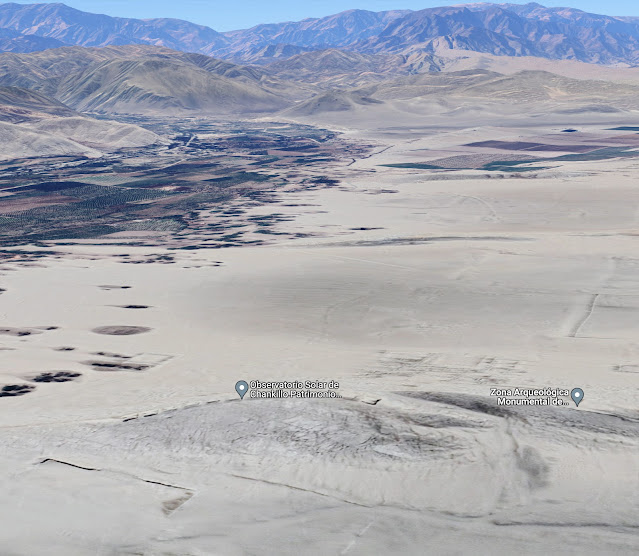It's true!
This IS a picture of the University of North Carolina very actively watering an artificial turf. I took this pic one sunny afternoon not long before the field hockey team was about to take the field. Of course, this struck me as nonsensical, but when you see things that seem truly odd, there's usually an explanation. That's this week's Challenge...
Why?
This week's Challenge:
1. Why do they water the artificial grass before (and sometimes during) a game?
In this case, when I was there I spotted the groundskeeper who was actually running the sprinkler and monitoring how well they were doing. Being a curious sort of fellow, I walked over, struck up a conversation and asked "Why are you watering the artificial grass?" His reply: "We do it a couple of hours before the game to make sure the field hockey balls (or lacrosse balls) won't run quite as far when they hit the surface. If it's dry, they move fast and run off the field too quickly... which is a hassle."
So, his answer: To increase the drag on the ball. He helpfully pointed out that on "hot days, we'll water the field during halftime for the same reason."
That's probably correct, but naturally, I was interested if there was any other reason. So I started my reading with:
[ field hockey water on surface ]
and found several good results. The UK's Express sports page says that "The artificial playing surface is actually watered on purpose before each hockey game in order to improve play. GreenFields, an artificial turf systems company, said: 'The pitch is fully irrigated with a layer of water which results in an extremely fast and professional game.'"
Interesting. That's not what the groundskeeper said. He said the reason is to have the balls move more slowly.
Greenfields goes on to say that "During a hockey match, an average of 6,000 litres of water is used to irrigate the pitch. This is enough drinking water for a 3-person household for 6.5 years!" (That's enough water to cause this Californian to pause.) They also go on to say that the reason for watering the field is to "lower the surface temperature" to something more like natural grass.
Looking around at other results I find that Halloran and Yauch (an irrigation systems company) say that watering an artificial field can:
a. lubricate the surface to reduce injuries;
b. cools the surface to reduce rug burns;
c. stabilize the surface to add to field life;
d. keeps the surface moist to prevent the synthetic fibers from breaking.
Similar arguments are made by the TigerTurf company (another artificial field provider).
On the other hand, searching for:
[ water on artificial turf soccer ]
leads me to several other articles that repeat the "cooling" story, but also to an article (ParksAndRecBusiness) pointing out that for the special case of field hockey, water on the astroturf provides "“Uniform ball bounce and a non-directional roll..."
Sounds like the PRIMARY reason is for this extravagant field watering is to make the field cooler--that makes sense, especially in places like North Carolina, which can get mighty warm. There's also probably a more consistent ball rolling behavior with water on the field, which might be slower, might be faster, but certainly more predictable.
Lest you think this is only an issue in places with lots of water, what kind of water you use on an artificial field matters--it's supposed to be potable water. So, in LA, the question comes up, does watering an artificial field use less water... or more... than natural grass. I will leave this as an open question for rabid sports fans to answer.
 |
| Where the stick hits the watery field... |
2. In what other sports do they water the field before (and sometimes during) a game? Why do they water those fields?
I did a generic search by:
[ "spray * on * field" sports ]
to find all mentions of spraying something (the first *) onto something followed by "field." I added sports to the query to get rid of results talking about spraying on agricultural fields.
And, I found what you'd expect: that they spray water on baseball infields (which are usually red clay, which gets mighty dusty), and they spray water for the same reason on horse-racing tracks. Of course, I also found many articles about spray-painting logos onto artificial turf for both permanent markings (e.g. lines), but temporary markings (e.g., for visiting team logos).
But the biggest surprise in these results was the observation that sometimes you need to spray artificial grass with weed killer! This led me to do a special search on:
[ spray herbicide on artificial grass ]
and discover that it's recommended to use a herbicide twice a year to control those pesky weeds that can even grow... on an artificial field.
SearchResearch Lessons
Search on!
P.S. I'll be away for the next two weeks, heading off on an actual vacation. You can guess that there will be more SearchResearch Challenges in the near future that draw upon what I see there. Details when I return. But don't take two weeks of quiet as me being MIA--it's just time for a bit of a break. The Challenge will return on May 11.
Bula vinaka!








